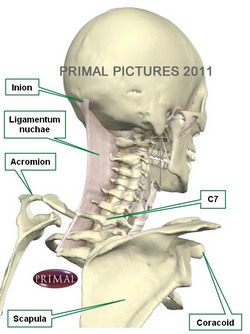The [ligamentum nuchae] is the Latin term to describe the nuchal ligament. It arises from the word [nucha] meaning the “back” or “nape” of the neck.
The ligamentum nuchae is a midline or median structure found in the posterior aspect of the neck. It is a fibroelastic tendon-like bilaminar structure with a triangular shape. Because of its location the ligamentum nuchae froms a septum that divides the posterior aspect of the neck in the midline providing an attachment for several muscles. These muscles are the trapezius, splenius capitis, rhomboid minor and serratus posterior superior.
The ligamentum nuchae attaches superiorly to the inion (external occipital protuberance) and the midline of the occipital bone. Inferiorly it attaches to the spinous process of C7 (vertebra prominens). Anteriorly it attaches to the posterior tubercle of C1 and all the cervical vertebrae in the midline. Interestingly, anatomical studies have shown the ligamentum nuchae to have small attachments to the spinal dural (thecal) sac superior and inferior to C1
There is a discussion as to the relationship of the ligamentum nuchae and the supraspinous and interspinous ligaments. Some say that the ligamentum nuchae is a discrete structure distinct from the supraspinous and interspinous ligaments, while others contest that the ligamentum nuchae is a continuation of the supraspinous and interspinous ligaments.
Thanks to Jackie Miranda-Klein for suggesting this article.




